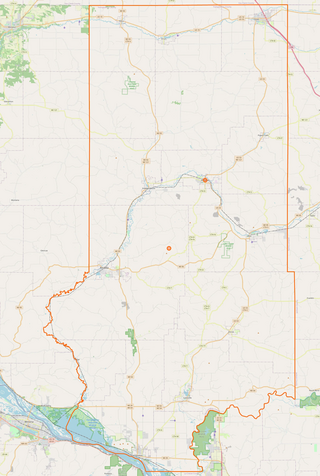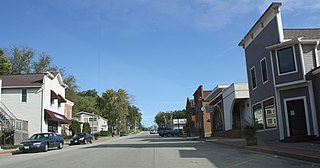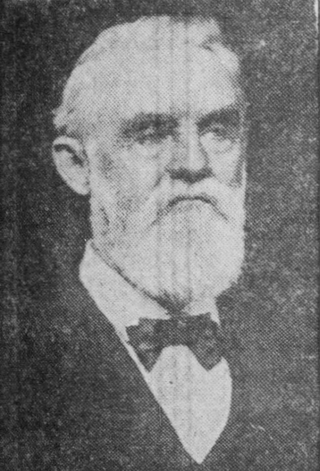
Trempealeau County is a county in the U.S. state of Wisconsin. As of the 2020 census, the population was 30,760. Its county seat is Whitehall. Many people of Polish, Norwegian and German descent live in this area.

Portage is a city in and the county seat of Columbia County, Wisconsin, United States. The population was 10,581 at the 2020 census, making it the largest city in Columbia County. The city is part of the Madison Metropolitan Statistical Area.

Galesville is a city in Trempealeau County, Wisconsin, United States. The population was 1,662 at the 2020 census. A dam on Beaver Creek is located at Galesville, forming Lake Marinuka north of the city. The mayor is Vince Howe.

Trempealeau is a village located along the Mississippi River in Trempealeau County in the U.S. state of Wisconsin. The population was 1,843 at the 2020 census. The village is surrounded by the Town of Trempealeau.
Charles Zeller Klauder was an American architect best known for his work on university buildings and campus designs, especially his Cathedral of Learning at the University of Pittsburgh, the first educational skyscraper.

The University of Wisconsin–La Crosse is a public university in La Crosse, Wisconsin. Established in 1909, it is part of the University of Wisconsin System and offers bachelor's, master's, and doctoral degrees. With 9,600 undergraduate and 1,000 graduate students, UW-La Crosse is composed of four schools and colleges offering 102 undergraduate programs, 31 graduate programs, and 2 doctoral programs. UW-La Crosse has over 85,000 alumni across all 50 U.S. states and 57 countries.

Kilian Caspar Flasch was a German-born prelate of the Roman Catholic Church who served as bishop of the Diocese of La Crosse in Wisconsin from 1881 until his death in 1891.

Elmore Yocum Sarles was an American politician who was the ninth Governor of North Dakota from 1905 to 1907.
This is an incomplete list of historic properties and districts at United States colleges and universities that are listed on the National Register of Historic Places (NRHP). This includes National Historic Landmarks (NHLs) and other National Register of Historic Places listings. It includes listings at current and former educational institutions.
James Arthur Temp was an American football player, businessman, and philanthropist.

George W. Gale was an American lawyer, judge, politician, and Wisconsin pioneer. He served as a Wisconsin Circuit Court Judge and as a member of the Wisconsin State Senate. He was the founder of Galesville, Wisconsin, and Gale College, and was a driving force behind the creation of Trempealeau County, Wisconsin.
Suzanne Jeskewitz is a former Wisconsin legislator and politician.

This is a list of the National Register of Historic Places listings in Trempealeau County, Wisconsin. It is intended to provide a comprehensive listing of entries in the National Register of Historic Places that are located in Trempealeau County, Wisconsin. The locations of National Register properties for which the latitude and longitude coordinates are included below may be seen in a map.

Alexander Ahab Arnold was an American lawyer, livestock breeder, and Republican politician from Galesville, Wisconsin. He was the 33rd speaker of the Wisconsin State Assembly and served two years in the Wisconsin State Senate, representing Trempealeau County.

The Ridge Avenue Historic District in Galesville, Wisconsin is a 5 acres (2.0 ha) historic district which was added to the National Register of Historic Places in 1984. The district contains eleven contributing properties; they are primarily located on Ridge Avenue between 4th and 6th Streets. The district was added for its architectural importance; it features buildings with Italian, Queen Anne, and other architectural styles dated between 1859 and 1934. The John F. Cance House is located near the district at 807 West Ridge Avenue.
Elmer Paul Petersen was an American sculptor who worked in metal. His most prominent artwork is the World's Largest Buffalo in Jamestown, North Dakota. Petersen lived and worked in Galesville, Wisconsin. Much of his art is publicly displayed around La Crosse, Wisconsin, where he led the Downtown La Crosse Sculpture Project Committee. The La Crosse Tribune called Petersen "one of the premier sculptors in the Coulee Region" and "instrumental in getting public sculpture scattered throughout downtown" La Crosse. He has worked significantly with welding, including that of found metal objects, and often sculpted in cast bronze.

Albert Theodore Twesme was an American lawyer, jurist, and Republican politician from Trempealeau County, Wisconsin. He represented Trempealeau County in the Wisconsin State Assembly during the 1909 session and later served as a county judge.

Gale-Ettrick-Trempealeau High School is a public high school in Galesville, Wisconsin. It educates students in grades 9 through 12 and is the only high school in the Gale-Ettrick-Trempealeau School District.

Isaac Clark was an American farmer, banker, and Republican politician. He served one term in the Wisconsin State Assembly, representing Trempealeau County.
Albert L. "Bud" Twesme was an American lawyer and judge from Trempealeau County, Wisconsin. He was county judge of Trempealeau County for 29 years, and was then the first chief judge of the 7th district of Wisconsin circuit courts, serving from 1978 until his retirement in 1983.




















